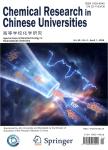Understanding on the Surfactants Engineered Morphology Evolution of Block Copolymer Particles and Their Precise Mesoporous Silica Replicas
作者机构:Lab of Low-Dimensional Materials ChemistryKey Laboratory for Ultrafine Materials of Ministry of EducationFrontier Science Center of the Materials Biology and Dynamic ChemistrySchool of Materials Science and EngineeringEast China University of Science and TechnologyShanghai 200237P.R.China Key Laboratory for Green Processing of Chemical Engineering of Xinjiang BingtuanSchool of Chemistry and Chemical EngineeringShihezi UniversityShihezi 832003P.R.China State Key Laboratory of High Performance Ceramics and Superfine MicrostructureShanghai Institute of CeramicsChinese Academy of SciencesShanghai 200050P.R.China
出 版 物:《Chemical Research in Chinese Universities》 (高等学校化学研究(英文版))
年 卷 期:2022年第38卷第1期
页 面:99-106页
核心收录:
学科分类:081704[工学-应用化学] 07[理学] 08[工学] 0817[工学-化学工程与技术] 070305[理学-高分子化学与物理] 080501[工学-材料物理与化学] 0805[工学-材料科学与工程(可授工学、理学学位)] 0703[理学-化学]
基 金:This work was supported by the National Natural Science Foundation of China (Nos.51621002,51972112,22005096) the Basic Research Program of Shanghai Municipal Government,China(Nos.21JC1406000,19JC1411700) the Shanghai Sailing Program,China(No.20YF1410100) the Leading Talents in Shanghai in 2018 of China and the 111 Project of China(No.B14018)
主 题:Binary co-assembly Block copolymer Surfactant Morphology evolution Mesoporous material
摘 要:Surfactant-directed block copolymer(BCP) particles have gained intensive attention owing to their attractive morphologies and ordered domains. However, their controllable fabrication suffers several limitations including complex design and synthesis of multiple surfactant systems, limited choices of block copolymers, and time-consuming post-processes, etc. Herein, a surfactant size-dependent phase separation route is proposed to precisely manipulate the architectures of the anionic block copolymer particles in the binary co-assembly system of BCP and surfactants. In the system of polystyrene block polyacrylic acid (PS-b-PAA) and quaternary ammonium surfactants, it is verified that facile control on the ordered phase separation structures and morphologies of BCP particles can be achieved via simply varying the alkyl lengths of the surfactants. The cationic surfactants are demonstrated participating in the fabrication of the internal structures of BCP particles. Especially, it is found that the cationic surfactants are integrate into the anionic polyacrylic acid(PAA) domain of BCP particles of PS-b-PAA to influence the volume fraction of PAA blocks, so that varied architectures of BCP particles are constructed. Based on these understandings, spherical or ellipsoidal BCP particles are obtained as expected, as well as their precisely inorganic mesoporous silica replicas through the block copolymer nanoparticle replicating route. More interestingly, the ellipsoidal mesoporous silica exhibits higher cellular internalization capability due to its lower energy expenditure during the internalization process, which presents promising potentials in biomedical applications, especially for high-efficient drug delivery systems. These findings may provide valuable insights into the confinement assembly of anionic block copolymers and the creation of special nanocarriers for high-efficiency biomacromolecule delivery in the biomedical community.



